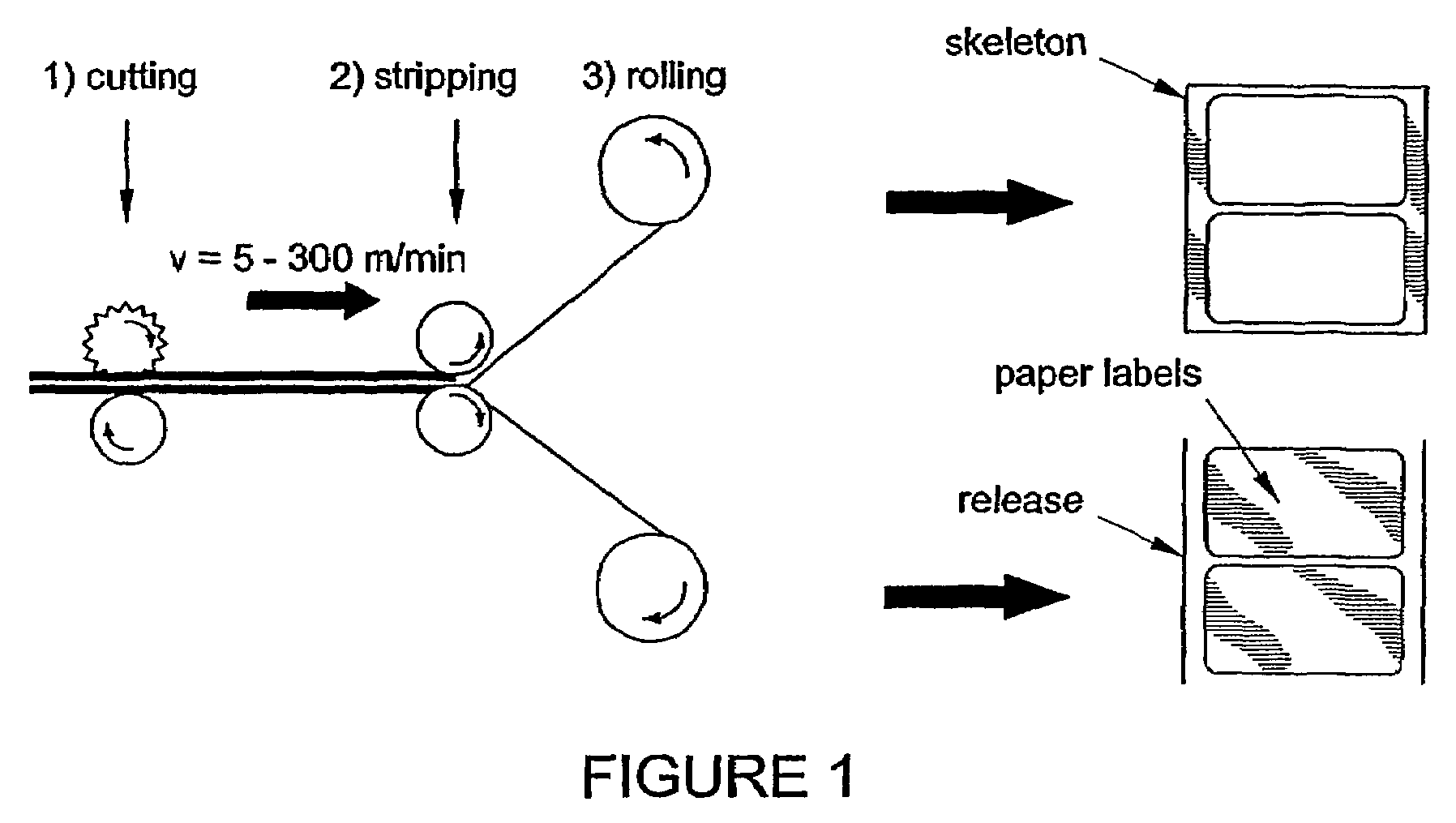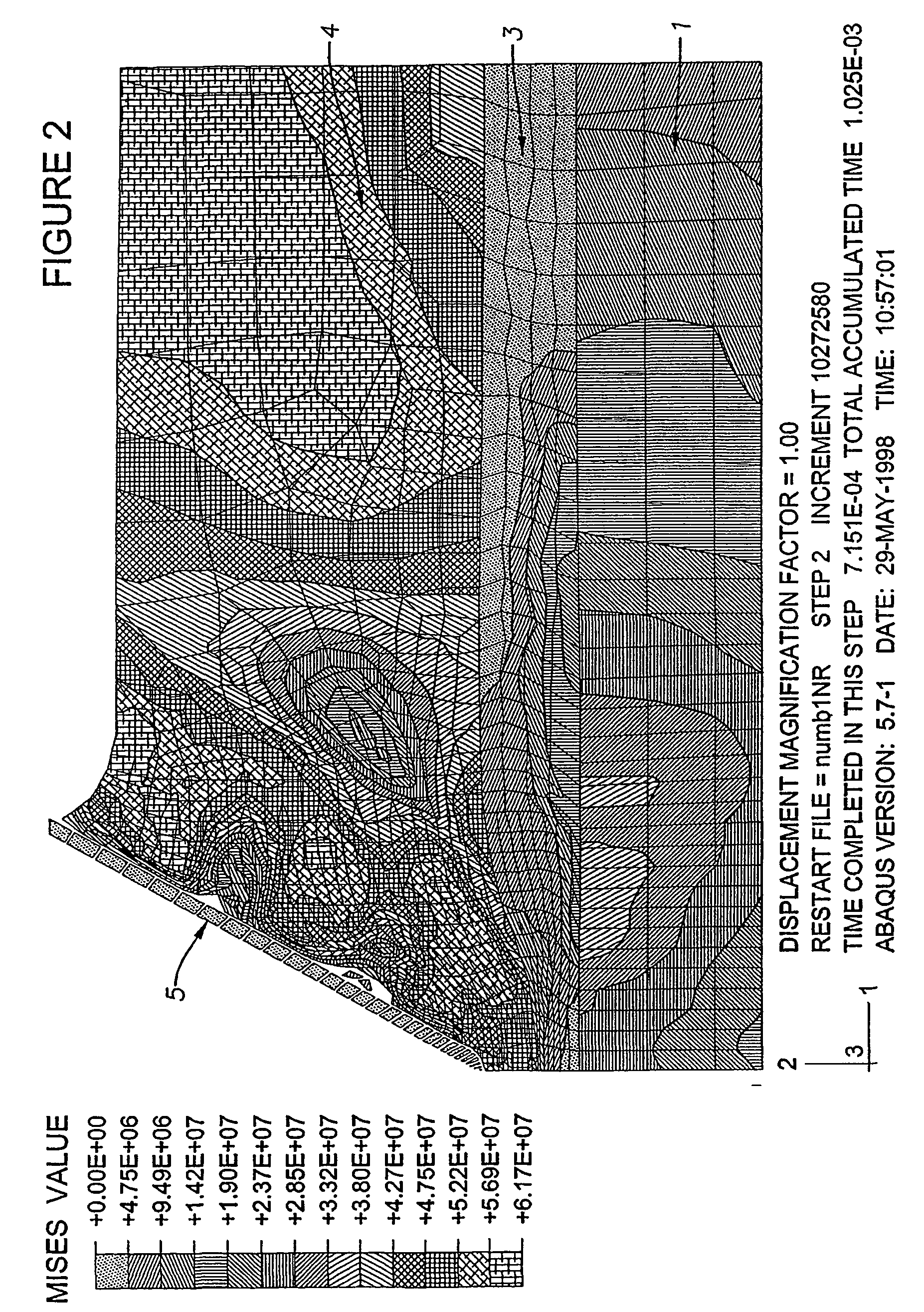Adhesives with improved die-cutting performance
a technology of adhesives and die-cutting, applied in the direction of film/foil adhesives, stamps, tyre parts, etc., can solve the problems of adhesive strings and adhesive deposits on the cutting blade, difficult and inconsistent die-cutting, and difficult to cut or break adhesive films, etc., to achieve easy and clean cut, less elastic, and easy to flow adhesives
- Summary
- Abstract
- Description
- Claims
- Application Information
AI Technical Summary
Benefits of technology
Problems solved by technology
Method used
Image
Examples
example 2
[0092]A SISI tetrablock copolymer in which the blocks were of molecular weight 12,400; 60,000; 12,400 and 70,000 respectively having an overall styrene content of 16 wt % was used in a hot melt formulation containing 31 wt % of polymer, 27 wt % of Wingtack 10, and 42 wt % of Escorez 1310 to which was added 0.4 wt % of Irganox 1076. The resulting hot melt showed the following characteristics:
[0093]
Brookfield Viscosity (175° C. - mPa · s)9800180° peel strength - N / 25 mmRoom temperature - glass33.3 pt 3° C. - glass22.8 ptRoom temperature - Polyethylene24.8 pt 3° C. - Polyethylene19.8 ptLoop Tack - Nglass at room temperature29.9 cfglass at 3° C.14.0 ptLoop Tack - NPolyethelyne at room temperature18.9 afPolyethylene at 3° C.12.7 ptShear - room temperature - hoursSteel - 25 * 25 mm - 1 kg42.1Migration - % reflection1 week 60° C.87.31 week 70° C.81.9pt means paper tearcf means cohesive failureaf means adhesive failure
[0094]The dynamic rheological properties are shown FIG. 5, where they are...
example 3
[0096]A SISI tetrablock copolymer in which the blocks were of molecular weight 10,330-30,450-10,330-91,400 respectively having an overall styrene content of 14 wt %. A hot melt formulation has been prepared with 41% of above polymer, 18% of Wingtack 10, and 41% of Escorez 1310 to which was added 0.4% of Irganox 1076. The resulting hot melt showed the following characteristics.
[0097]
Brookfield Viscosity (175° C. - mPa · s)26600180° peel strength - N / 25 mmRoom temperature - glass27.3 cf + pt 3° C. - glass25.3 ptRoom temperature - Polyethylene25.0 cf + pt 3° C. - Polythylene22 afLoop Tack - Nglass at room temperature37.8 cfglass at 3° C.16.6 ptLoop Tack - NPolyethylene at room temperature19.1 afPolyethylene at 3° C.5.3 jShear - room temperature - hoursSteel - 25 * 25 mm - 1 kg31-cfMigration - % reflection1 week 60° C.902 weeks 60° C.891 week 70° C.812 weeks 70° C.78j means jerking
[0098]The dynamic rheological properties of the formulation are shown FIG. 6, where they are compared with ...
example 4
[0100]A SISB tetrablock copolymer in which the blocks were of weight-average molecular weight 11,300; 61,000; 11,300 and 42,500 respectively having an overall styrene content of 17 wt % was used. A hot melt formulation has been prepared with 31% of this polymer, 27% of Wingtack 10, and 42% of ECR 373 to which was added 0.4% of Irganox 1076. The resulting hot melt showed the following characteristics.
[0101]
Brookfield Viscosity (175° C. - mPa · s)1000180° peel strength - N / 25 mmRoom temperature - glass35.5 pt 3° C. - glass24.2 ptRoom temperature - Polyethylene23.5 af 3° C. - Polythylene21.8 ptLoop Tack - Nglass at room temperature 26 cfglass at 3° C.20.8 ptLoop Tack - NPolyethylene at room temperature18.1 afPolyethylene at 3° C.13.3 ptShear - room temperature - hoursSteel - 25 * 25 mm - 1 kg52.7 cfMigration - % reflection1 week 60° C.58.12 weeks 60° C.52.21 week 70° C.47.244.4
[0102]The dynamic rheological properties are shown in FIG. 7, where they are compared with those of Comparati...
PUM
| Property | Measurement | Unit |
|---|---|---|
| storage modulus | aaaaa | aaaaa |
| storage modulus | aaaaa | aaaaa |
| storage modulus | aaaaa | aaaaa |
Abstract
Description
Claims
Application Information
 Login to View More
Login to View More - R&D
- Intellectual Property
- Life Sciences
- Materials
- Tech Scout
- Unparalleled Data Quality
- Higher Quality Content
- 60% Fewer Hallucinations
Browse by: Latest US Patents, China's latest patents, Technical Efficacy Thesaurus, Application Domain, Technology Topic, Popular Technical Reports.
© 2025 PatSnap. All rights reserved.Legal|Privacy policy|Modern Slavery Act Transparency Statement|Sitemap|About US| Contact US: help@patsnap.com



